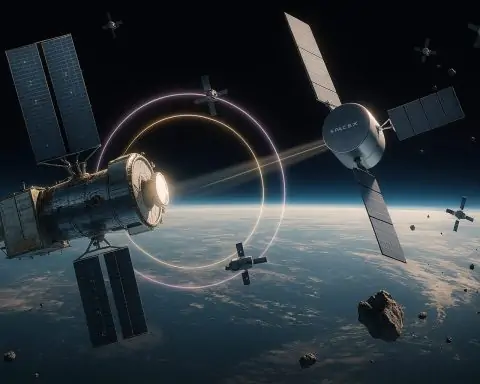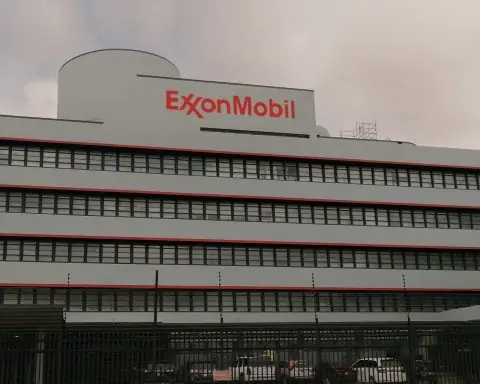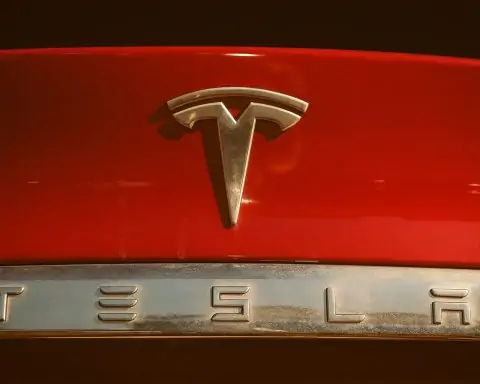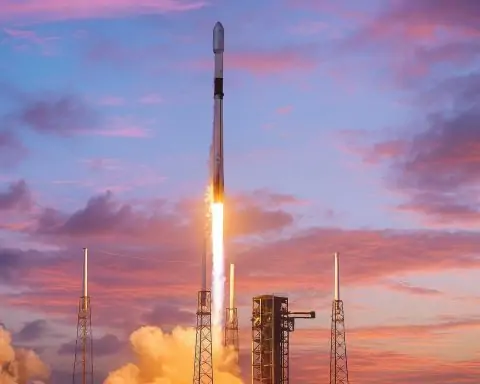Key Facts
- NASA introduced its 2025 class of astronaut candidates on Sept. 22, selected from over 8,000 applicants, marking the first new group of NASA trainee astronauts since 2021 [1] [2]. The new recruits will undergo ~2 years of training for future missions to the Moon, Mars, and low Earth orbit.
- Back-to-back rocket launches made headlines: SpaceX launched 28 Starlink internet satellites from Florida on Sept. 21 – its 119th Falcon 9 flight of the year [3] – followed by a classified NROL-48 mission on Sept. 22, sending up Starshield satellites for the U.S. National Reconnaissance Office [4]. Both missions saw successful booster landings.
- NASA and NOAA prepped a major space weather launch: On Sept. 21, officials held briefings ahead of the Interstellar Mapping and Acceleration Probe (IMAP) launch set for Sept. 23. IMAP and its two rideshare satellites – NASA’s Carruthers Geocorona Observatory and NOAA’s SWFO-L1 solar storm monitor – will lift off together on a SpaceX Falcon 9 to explore the Sun-Earth environment from the L1 point [5] [6].
- Blue Origin returned to flight and looks ahead: After a month-long delay, Jeff Bezos’ company flew its 35th New Shepard suborbital mission on Sept. 18, lofting over 40 research payloads (including student experiments) above the Kármán line and safely landing the capsule and booster in West Texas [7] [8]. Looking to deep space, Blue Origin is gearing up for the second launch of its heavy-lift New Glenn rocket on Sept. 29, which will carry NASA’s twin ESCAPADE Mars probes toward the Red Planet [9].
- Groundbreaking science news emerged: NASA confirmed discovery of the 6,000th exoplanet – a milestone three decades after the first such planet was found. These confirmed worlds range from lava-boiling “hell” planets to gas giants with “Styrofoam-light” density and gemstone clouds, underscoring the staggering diversity of alien worlds [10]. “This milestone represents decades of exploration… a foundation to answering ‘Are we alone?’,” said NASA’s acting astrophysics chief Shawn Domagal-Goldman [11]. Meanwhile, the Event Horizon Telescope collaboration revealed unprecedented magnetic turbulence at a black hole’s edge, observing that the polarization around M87 changed markedly from 2017 to 2021 – evidence of dynamic, previously unknown physics near the event horizon [12] [13].
- Global developments in space continued: NASA and the European Space Agency solidified a partnership to land Europe’s ExoMars “Rosalind Franklin” rover in 2028, with NASA providing the launcher, descent engines and heaters to replace now-unavailable Russian components [14] [15]. International crews in orbit stayed busy as well – China’s Shenzhou-20 astronauts aboard the Tiangong space station conducted experiments on space radiation cancer risks and biotech in microgravity [16], while 11 astronauts on the ISS unpacked supplies and began new materials science and biomedical studies. Space policymakers, meanwhile, grappled with security and sustainability: India announced plans for “bodyguard” satellites to protect its assets after a close-call in orbit [17], and U.S. lawmakers faced a looming Oct. 1 government shutdown that could disrupt space agency operations if not averted [18].
Major Launches and Mission Updates
NASA’s Space Weather Trio Set for Launch: At Kennedy Space Center, NASA and NOAA are on the cusp of launching three spacecraft that promise new insight into solar storms and the Solar System’s boundary. On Sept. 21, officials declared the IMAP mission (“Interstellar Mapping and Acceleration Probe”) and its two co-manifested satellites “go” for launch [19]. IMAP will travel ~1.5 million km sunward to the Sun–Earth L1 point to map the heliosphere – the magnetic bubble shielding our Solar System – and study how solar wind particles and cosmic rays interact at that frontier [20] [21]. Riding along is NOAA’s Space Weather Follow-On (SWFO-L1), designed to give Earth ~30 minutes advance warning of solar eruptions, and NASA’s Carruthers Geocorona Observatory, a smallsat that will image Earth’s outermost atmosphere (the exosphere) in ultraviolet light [22] [23]. Liftoff is scheduled for Sept. 23 at 7:32 a.m. EDT on a SpaceX Falcon 9 from Launch Complex 39A, with coverage on NASA TV and the new NASA+ streaming service [24] [25].
“These three missions will map our Sun’s influence across the solar system in new ways,” NASA officials said of IMAP, SWFO-L1 and Carruthers, noting that all will operate continuously at L1 to help safeguard Earth from space weather and probe cosmic boundaries [26] [27]. The Carruthers observatory, named after Apollo-era astronomer George Carruthers, even continues an experiment first done during Apollo 16 by imaging the Earth’s geocorona (far ultraviolet glow) to see how solar storms affect our atmosphere [28].
SpaceX’s Rapid-Fire Launch Cadence: Elon Musk’s SpaceX notched two orbital launches in as many days. In the pre-dawn hours of Sept. 21, a Falcon 9 lifted off from Cape Canaveral carrying 28 Starlink broadband satellites. The booster – flying its 11th mission – successfully landed on the drone ship A Shortfall of Gravitas in the Atlantic [29] [30]. This Starlink Group 10-27 mission pushed SpaceX to 119 Falcon 9 launches in 2025 to date [31], underscoring the company’s record-breaking launch tempo. Just one day later on Sept. 22, another Falcon 9 roared off Vandenberg Space Force Base in California carrying a national security payload: the NROL-48 mission for the U.S. National Reconnaissance Office. While details are classified, public manifests suggest it deployed the 11th batch of SpaceX-built “Starshield” satellites – a proliferated low-Earth orbit constellation for U.S. defense and intelligence agencies [32]. SpaceX did not provide a live webcast (standard for NRO flights), but confirmation of mission success came shortly after launch. The Falcon 9’s first stage touched down at a California landing zone, marking SpaceX’s second orbital launch and landing in 24 hours.
Blue Origin’s Suborbital Comeback and New Glenn Prep: Blue Origin also made news with both suborbital and orbital rockets. On Sept. 18, the company conducted the long-delayed NS-35 flight of New Shepard, its reusable suborbital vehicle. Liftoff occurred at 9:01 a.m. EDT from Blue Origin’s West Texas site, without any crew on board [33] [34]. Instead, the capsule carried a cargo of over 40 scientific and educational payloads, including 24 experiments from NASA’s TechRise Student Challenge (middle- and high-school teams) and thousands of Club for the Future postcards sent in by kids [35] [36]. The flight – lasting about 10 minutes – saw the booster rocket safely propulsively land ~2 miles from the pad and the capsule descend under parachutes, capping a successful return to service [37]. (New Shepard had been grounded for nearly a month due to an avionics issue that scrubbed two prior attempts [38].)
Looking ahead, Blue Origin is turning its focus back to orbital launches. The company’s much larger New Glenn rocket is slated for its second flight on Sept. 29, pending final readiness. Notably, that mission will loft NASA’s ESCAPADE spacecraft – twin small Mars orbiters – on the first leg of their journey to the Red Planet [39]. This marks Blue Origin’s first NASA interplanetary launch contract. (New Glenn’s inaugural flight earlier this year carried a commercial satellite payload and validated the rocket’s performance after years of development.) Blue Origin has not announced if it will attempt to recover New Glenn’s massive first stage, but the rocket’s successful debut has positioned it as a new heavy-lift option alongside SpaceX’s Falcon Heavy and ULA’s Vulcan.
Artemis Updates – New Astronauts and a Moon Mission Preview: In human spaceflight news, NASA’s Johnson Space Center was abuzz as it unveiled a new class of astronaut candidates on Sept. 22. The agency spent the past year sifting through over 8,000 applicants, ultimately selecting a group of around 10–12 elite candidates (the exact number was to be revealed at the event) [40]. These men and women – engineers, scientists, pilots, and doctors – now begin two years of intensive training in spacecraft systems, spacewalking, robotics, and Russian language, after which they may join missions to the International Space Station, Artemis lunar flights, or even future Mars expeditions [41] [42]. The astronaut announcement was livestreamed on NASA TV and NASA’s social channels, generating excitement as this is the first new cohort since the “Artemis Generation” class of 2021.
On Sept. 23 and 24, NASA also scheduled briefings to preview the Artemis II Moon mission – a crewed test flight around the Moon planned for spring 2026 [43]. Artemis II will send four astronauts (including Canada’s Jeremy Hansen) on a 10-day voyage looping around the Moon in an Orion capsule, the first time humans will travel beyond low Earth orbit in over 50 years. In the briefings, mission managers and astronauts are to discuss the flight profile – a free-return lunar swing-by about 1 million km from Earth – and test objectives such as validating Orion’s life support systems and performing navigation experiments [44] [45]. They’ll also highlight the science and tech payloads riding along: Artemis II plans to deploy 10 CubeSats in deep space and carry microgravity experiments (like organ-on-a-chip tissue studies) to gauge radiation effects outside Earth’s magnetosphere [46]. The week culminates with an Artemis II crew press conference and media day on Sept. 24, giving reporters a chance to tour JSC’s training facilities and interview the crew and mission team [47].
Scientific Breakthroughs and Space Exploration Highlights
Exoplanet Milestone – 6,000 Worlds and Counting: Humanity’s cosmic inventory of alien worlds hit a landmark number this weekend. On Sept. 21, NASA’s Exoplanet Science Institute officially confirmed the 6,000th exoplanet beyond our Solar System [48]. There was no single “6000th planet” discovery; rather, the count crossed the threshold after a batch of new confirmations were added to the archive. It comes just 3½ years after the 5,000-planet mark was reached, reflecting an accelerating pace of discovery by missions like Kepler, TESS, and others [49]. “This milestone represents decades of cosmic exploration… that have completely changed how humanity views the night sky,” said Dr. Shawn Domagal-Goldman, acting director of NASA’s Astrophysics Division [50]. Indeed, in those decades we’ve learned that rocky Earth-like planets are common, but so are exotic worlds nothing like our own: “hot Jupiters” hugging close to their stars, planets orbiting multiple suns or dead stellar remnants, lava oceans, ultra-low-density “cotton candy” giants, and even atmospheres laced with metals and glassy minerals [51] [52]. Researchers emphasize that studying this menagerie – over 8,000 additional planet candidates await confirmation – is key to understanding how planetary systems form and to honing the search for another Earth. With upcoming heavy hitters like the Nancy Grace Roman Space Telescope (launching mid-decade) and ESA’s Gaia and PLATO missions, scientists expect the exoplanet tally to surge into the tens of thousands, improving the odds of finding potentially habitable worlds [53] [54].
Black Hole “Heartbeat” Discovered – New Physics at M87: Scientists observing the supermassive black hole M87 (6.5 billion solar masses at the center of the Virgo Galaxy) reported a groundbreaking discovery: the environment right outside the black hole’s event horizon is far more dynamic than previously known. Using data from upgraded Event Horizon Telescope campaigns, astronomers found that the polarization of light around M87 – essentially the orientation of electromagnetic waves, which reveals the structure of magnetic fields – changed dramatically between 2017 and 2021 [55] [56]. The EHT’s first-ever image of M87, unveiled in 2019 as a fuzzy orange ring, appeared static; but follow-up observations have now resolved time variability in the ring’s polarization pattern. In 2017 the polarization angle swung one way; by 2021 it had rotated into a completely new orientation [57]. This implies that the magnetic fields just outside the event horizon are turbulent and roiling – a magnetic “carousel” whipping around the black hole. Yet intriguingly, the overall diameter of the bright ring remained stable and consistent with Einstein’s relativity [58]. It’s as if the “shadow” of the black hole is steady, but its magnetic heartbeat is rapidly fluctuating.
These observations challenge theoretical models that treated the region near the event horizon as relatively constant. The fact that magnetic fields are so highly dynamic suggests previously unknown plasma processes are at work, as infalling matter and energy are chaotically channeled into M87’s powerful jets [59] [60]. Researchers are excited, noting this could be the “smoking gun” of new physics in extreme gravity environments. Follow-up studies will aim to correlate the polarization swings with any changes in M87’s jet brightness or high-energy emissions. The discovery underscores the importance of next-generation EHT efforts (adding more radio telescopes globally and even in space) to make movies of black holes that capture these temporal changes. As the EHT team put it, the observations give “the most detailed view yet” of magnetic chaos around a black hole and will help unlock how such monsters shape their galaxies [61].
Mars and Moon Exploration Updates: Beyond the headline-grabbing science above, there were other notable space exploration developments. In the realm of Mars exploration, Europe’s long-delayed ExoMars rover program took a concrete step forward in its post-Roscosmos era. ESA announced it signed a memorandum with NASA that guarantees U.S. support for ExoMars Rosalind Franklin’s 2028 launch and landing [62]. Under the deal, NASA will provide a commercial launch vehicle (likely a U.S. heavy-lift rocket) and crucial landing hardware – including braking engines and radioisotope heater units – to deliver the European rover safely to the Martian surface [63] [64]. This replaces the Russian Proton launcher and Kazachok lander that were lost to the mission after ESA terminated cooperation due to the Ukraine invasion. ESA Director General Josef Aschbacher praised the agreement, noting it allows Europe to “take responsibility” for the mission while “working with our American friends” who stepped in with contributions [65]. With this support in place, the Rosalind Franklin rover (built in the UK) is back on track to launch in September 2028 and search for signs of ancient life on Mars, drilling up to 2 meters beneath the surface in a once-habitable plain. Additionally, at an international Mars conference in mid-September, mission scientists unveiled a detailed landing site map for ExoMars and discussed ongoing testing of the rover’s autonomous navigation system [66] [67]. Mars exploration remains a globally collaborative effort – just as NASA and ESA work on ExoMars, they also continue partnering on Mars Sample Return, and China is independently developing its own sample-return mission for later this decade.
Meanwhile, around Earth’s Moon, activity is picking up as multiple programs progress. In lunar orbit, NASA’s Artemis I mission (uncrewed test of Orion) may be history, but its small secondary payloads continue to yield data – for instance, one CubeSat from Artemis I recently reported findings on water ice distribution in lunar soil. On the surface, private robotic missions are lining up: Japan’s ispace and America’s Intuitive Machines both aim to attempt lunar landings in the coming months (after some delays), carrying government and commercial payloads. And looking further out, the international Artemis coalition grows: by this weekend, 56 countries have signed the Artemis Accords, committing to peaceful cooperation in space [68]. NASA and its partners (including ESA, JAXA, CSA and others) are actively building hardware for a Moon-orbiting Gateway station and new lunar landers. At the International Astronautical Congress next week (opening Sept. 29 in Sydney), agencies will be announcing new lunar science campaigns and possibly crew assignments for upcoming Artemis flights. The space race to the Moon has clearly shifted into high gear, with both government and private actors eager to stake out a presence.
International Collaboration and Space Policy Developments
Space Station and International Crew Updates: The 23-year-old International Space Station (ISS) remains a focal point of global cooperation. This weekend the ISS had a bumper crew of 11 onboard (after a recent crew rotation), including astronauts from the U.S., Russia, Europe, and Japan. The crews are busy activating a slew of new experiments delivered by recent cargo ships. According to mission reports, astronauts began tests on semiconductor crystal growth and pharmaceutical development in microgravity, set up a new ultraviolet sanitation unit to evaluate spacecraft disinfecting methods, and even installed hardware to study 3D-“bioprinted” human tissue (liver cells) and how it behaves in orbit [69] [70]. On the Russian side, cosmonauts configured an experiment to observe dust plasma physics. This week also saw stunning Earth imagery, with crewmembers photographing glaciers in Patagonia and dust storms over Africa as part of climate observation duties. Policy-wise, despite geopolitical tensions on Earth, the ISS partnership stays strong: all five partner agencies (NASA, Roscosmos, ESA, JAXA, CSA) have indicated support to extend ISS operations to 2030, pending final approvals [71]. (Japan was the first to formally commit, and ESA’s member states agreed in principle to fund ISS through 2030 [72]. Russia has signaled it will likely concur as long as its modules remain technically sound [73].) This extension ensures a continued multinational human presence in orbit while NASA and partners build the Artemis Gateway and commercial space stations for the post-ISS era.
China’s Tiangong and Eastern Hemisphere Cooperation: Not to be overlooked, China’s Tiangong space station is now fully operational with its three-module configuration (Tianhe, Wentian, Mengtian) and a three-person crew aboard. The Shenzhou-20 mission crew – Commander Chen Dong and taikonauts Wang Jie and Chen Zhongrui – have been in orbit for about two months and are engaged in a variety of research [74]. Chinese state media reports that they are conducting experiments in neuroscience, bioengineering, microgravity physics, and technology demonstrations. One highlighted study involves exposing tumor cell samples to the station’s radiation environment to better understand cancer risks from cosmic radiation [75]. They are also testing a new nucleic acid therapy experiment in microgravity, which could inform novel medical treatments. In addition to science, the crew performs station maintenance (from treadmill servicing to smoke detector tests and general housekeeping) to keep Tiangong running smoothly [76]. China has been steadily expanding international participation in its space endeavors: it has invited experiments from European and Asian partners to fly on Tiangong, and during a Space Technology Innovation Conference in Shanghai this week [77], Chinese officials reiterated that foreign astronauts will be welcome on the station in coming years. Already, cooperation agreements exist for Pakistani and possibly Saudi astronauts to train for Tiangong missions. This all comes as China and Russia continue discussions on a proposed International Lunar Research Station (ILRS) on the Moon in the 2030s, an alternative vision to the U.S.-led Artemis program.
Geopolitics and Space Security: In the realm of space security and policy, the period saw significant moves by national defense space agencies. In New Delhi, officials with India’s space and defense departments revealed plans for a new suite of “bodyguard” satellites to protect India’s high-value satellites from potential threats [78]. This initiative was prompted by a recent near-miss in which an Indian military satellite came uncomfortably close to an object (reportedly a fragment of a Chinese satellite or spent rocket). The proposed “bodyguard” system might involve orbiting sentry satellites that can maneuver to inspect, block, or even nudge objects that pose a collision or interference risk to India’s assets – essentially an anti-satellite defense shield. Though details are sparse, the news underscores how space is increasingly seen as a strategic domain, with countries like India, the U.S., and China investing in both offensive and defensive space capabilities. In Washington, D.C., the annual Air & Space Forces Association conference (Sept. 21–23) convened military space leaders who echoed similar themes. U.S. Space Force Chief Gen. Chance Saltzman stressed the need to prepare for “a war that extends into space,” even as he noted that conflict in space is not inevitable and diplomacy is crucial. The Space Force announced new training exercises and technologies aimed at improving satellite resilience and rapid reconstitution of space assets if attacked.
On the civil side of policy, a pressing issue is the impending U.S. government shutdown deadline of Oct. 1. As of Sept. 22, Congress had yet to pass a budget or continuing resolution, raising the specter of a funding lapse. NASA, NOAA, and other space-related agencies are drawing up contingency plans: a shutdown could pause NASA mission planning, furlough most NASA employees, and delay contract payments, except for operations deemed essential (like active missions on ISS or planetary spacecraft that require monitoring) [79]. Launch schedules might slip if range personnel are furloughed. The situation remains fluid, but space industry groups have urged lawmakers to avoid disruption, noting that a brief shutdown in 2019 cost NASA tens of millions and delayed science reviews. International partners are also watching closely, since NASA’s participation in projects like Artemis and Mars Sample Return could be affected if budget uncertainty drags on. By the end of the weekend, House and Senate leaders were in a stalemate, making a shutdown increasingly likely – an unwelcome wildcard for the space sector as a busy fall of missions approaches.
Conclusion: From new astronauts ready to train for the Moon, to rockets launching seemingly every day, to breakthrough insights about planets and black holes, the past 48 hours showcased the full sweep of modern space endeavors. Government agencies and private companies alike are pushing the envelope: launching more, learning more, and collaborating across borders – even as competition and security concerns grow. The weekend of Sept. 21–22, 2025 will be remembered as a mini-inflection point in this new era of space activity. In just two days, we saw the next generation of explorers introduced, multiple missions launched or prepared that will shape our ability to live and work in space, and discoveries that deepen our understanding of the universe. And as nations negotiate rules and partnerships for the final frontier, one thing is clear: the pace of space news is only accelerating, setting the stage for even bigger leaps in the near future.
Sources: Space.com [80] [81]; NASA News Releases [82] [83]; SpacePolicyOnline [84] [85]; ScienceDaily [86] [87]; Universe Magazine [88] [89]; SpaceCalendar [90] [91]; Reuters/Bloomberg [92].
References
1. www.nasa.gov, 2. www.nasa.gov, 3. www.space.com, 4. en.wikipedia.org, 5. science.nasa.gov, 6. science.nasa.gov, 7. www.space.com, 8. www.space.com, 9. www.space.com, 10. www.sciencedaily.com, 11. www.sciencedaily.com, 12. universemagazine.com, 13. universemagazine.com, 14. www.nasa.gov, 15. www.nasa.gov, 16. www.spacecalendar.com, 17. www.bloomberg.com, 18. spacepolicyonline.com, 19. science.nasa.gov, 20. www.nasa.gov, 21. science.nasa.gov, 22. www.nasa.gov, 23. www.nasa.gov, 24. www.nasa.gov, 25. science.nasa.gov, 26. www.nasa.gov, 27. www.spacecalendar.com, 28. www.nasa.gov, 29. www.space.com, 30. www.space.com, 31. www.space.com, 32. en.wikipedia.org, 33. www.space.com, 34. www.space.com, 35. www.space.com, 36. www.space.com, 37. www.space.com, 38. www.space.com, 39. www.space.com, 40. www.nasa.gov, 41. www.nasa.gov, 42. www.nasa.gov, 43. www.nasa.gov, 44. www.spacecalendar.com, 45. www.spacecalendar.com, 46. www.spacecalendar.com, 47. www.spacecalendar.com, 48. www.sciencedaily.com, 49. www.sciencedaily.com, 50. www.sciencedaily.com, 51. www.sciencedaily.com, 52. www.sciencedaily.com, 53. www.sciencedaily.com, 54. www.sciencedaily.com, 55. universemagazine.com, 56. universemagazine.com, 57. universemagazine.com, 58. universemagazine.com, 59. universemagazine.com, 60. universemagazine.com, 61. universemagazine.com, 62. www.nasa.gov, 63. www.nasa.gov, 64. www.nasa.gov, 65. spacepolicyonline.com, 66. www.space.com, 67. www.space.com, 68. www.nasa.gov, 69. www.spacecalendar.com, 70. www.spacecalendar.com, 71. spacepolicyonline.com, 72. spacepolicyonline.com, 73. spacepolicyonline.com, 74. www.spacecalendar.com, 75. www.spacecalendar.com, 76. www.spacecalendar.com, 77. www.spacecalendar.com, 78. www.bloomberg.com, 79. spacepolicyonline.com, 80. www.space.com, 81. www.space.com, 82. www.nasa.gov, 83. www.nasa.gov, 84. spacepolicyonline.com, 85. spacepolicyonline.com, 86. www.sciencedaily.com, 87. www.sciencedaily.com, 88. universemagazine.com, 89. universemagazine.com, 90. www.spacecalendar.com, 91. www.spacecalendar.com, 92. www.bloomberg.com










